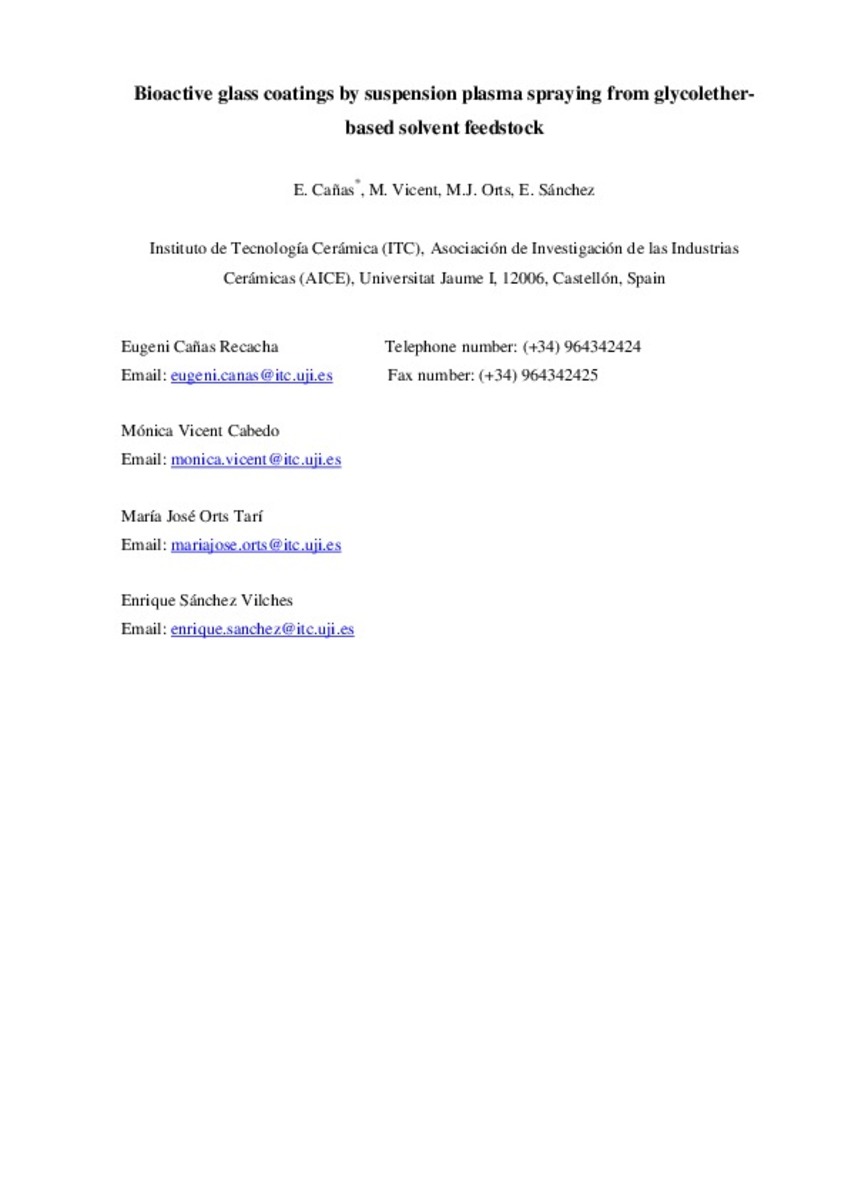Mostrar el registro sencillo del ítem
Bioactive glass coatings by suspension plasma spraying from glycoletherbased solvent feedstock
| dc.contributor.author | Cañas Recacha, Eugeni | |
| dc.contributor.author | Vicent Cabedo, Mónica | |
| dc.contributor.author | Orts Tarí, María José | |
| dc.contributor.author | Sánchez-Vilches, Enrique | |
| dc.date.accessioned | 2018-01-12T19:40:05Z | |
| dc.date.available | 2018-01-12T19:40:05Z | |
| dc.date.issued | 2017 | |
| dc.identifier.citation | Cañas, E., Vicent, M., Orts, M. J., & Sánchez, E. (2017). Bioactive glass coatings by suspension plasma spraying from glycolether-based solvent feedstock. Surface and Coatings Technology, 318, 190-197. | ca_CA |
| dc.identifier.issn | 0257-8972 | |
| dc.identifier.issn | 1879-3347 | |
| dc.identifier.uri | http://hdl.handle.net/10234/171826 | |
| dc.description.abstract | Bioactive glasses are emerging as a substitute of hydroxyapatite in the development of bioactive coatings for biomedical applications. The deposition of these coatings is carried out by a wide range of methods, being atmospheric plasma spraying the most employed technique. However, the research on the deposition of these coatings from suspension feedstocks by thermal spraying is still incipient, therefore more research about this topic is needed. Thus, a bioactive glass suspension, composed of fine glass particles, was prepared and stabilised through rheological and sedimentation tests to be used as a feedstock in plasma spraying. The solvent used in the suspension preparation was dipropylene glycol methyl ether in order to develop a new type of bioactive suspension. Consequently, as a new type of solvent was used, its effect on the plasma torch properties was determined. On other hand, the rheological behaviour of the suspension feedstock was assessed by means of a simple viscosity model. This suspension was deposited onto metallic substrates by plasma spraying, employing several spraying distances. All coatings displayed a suitable adherence and similar thickness. However, the microstructure of the obtained coatings is highly affected by the spraying distance as it can be seen in coatings surface and cross-section field emission gun environmental scanning electron microscopy examination. Thus, a relation between the spraying distance and coatings microstructure was found. On the other hand, X-ray diffraction confirmed the amorphous nature of the obtained coatings. | ca_CA |
| dc.format.extent | 30 p. | ca_CA |
| dc.format.mimetype | application/pdf | ca_CA |
| dc.language.iso | cat | ca_CA |
| dc.publisher | Elsevier | ca_CA |
| dc.relation.isPartOf | Surface and Coatings Technology, 2017, vol. 318, p. 190-197. | ca_CA |
| dc.rights.uri | http://rightsstatements.org/vocab/CNE/1.0/ | * |
| dc.subject | bioactive glass suspensions characterisation | ca_CA |
| dc.subject | ability of heating factor | ca_CA |
| dc.subject | suspension plasma spraying | ca_CA |
| dc.subject | bioactive glass coatings | ca_CA |
| dc.title | Bioactive glass coatings by suspension plasma spraying from glycoletherbased solvent feedstock | ca_CA |
| dc.type | info:eu-repo/semantics/article | ca_CA |
| dc.identifier.doi | https://doi.org/10.1016/j.surfcoat.2016.12.060 | |
| dc.relation.projectID | The authors of the present work thank Universitat Jaume I of Castellón the support provided in funding RECUBIO project (P1–1B2013–69) and action 3.1. of the Research Promotion Plan (PREDOC/2015/50) | ca_CA |
| dc.rights.accessRights | info:eu-repo/semantics/openAccess | ca_CA |
| dc.relation.publisherVersion | http://www.sciencedirect.com/science/article/pii/S0257897216313494 | ca_CA |
| dc.type.version | info:eu-repo/semantics/submittedVersion | ca_CA |
Ficheros en el ítem
Este ítem aparece en la(s) siguiente(s) colección(ones)
-
QUI_Articles [296]







